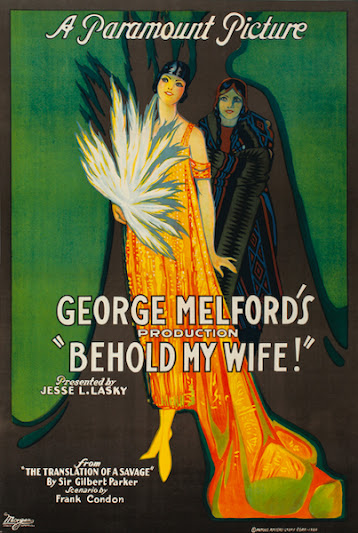Being an addendum to the recent post on The Translation of a Savage by Gilbert Parker.
Hollywood has blessed us with twenty-three adaptations of Gilbert Parker stories. I've managed to see just one, but not for want of effort. This post concerns the three adaptations of The Translation of a Savage, Parker's 1893 bestselling novel. As I'm intent on getting through all three in one post, criticism and snide comments will be kept to a minimum.
Promise.
A "short," but how short? Amongst lost silent films, Translation is so lost that even its run time is unknown. The Edison Films advert above from the May 1913 Moving Pictures World provides a glimpse of what we are missing. Do not be tempted by Newcombe's Necktie, it's The Translation of a Savage we're interested in here.
The description, "little savage" included, is in keeping with Parker's novel. The very same issue of Moving Picture World issue provides this synopsis:
In Parker's novel, Greyhope, the Armour family home, is in Herefordshire, not Staffordshire; a minor, seemingly inexplicable change. Much more significant is the description of Lali as "the daughter of a primitive trapper" and not the offspring of an "Indian chief." The surviving credits include a character named "Henri - the Trapper," suggesting French Canadian or possibly Métis heritage. We may never know. What I do know is that in Parker's imaginings Lali never runs and hides in the hedges.
Oh, how I wish I could include an image of Lili "looking beautiful in the dress of a woman of to-day," but I've yet to find a single image related to this film.
A better title, would you not agree?
This second adaptation holds no ambiguity; Lali is an "Indian." Of all the material attached to the film, this lobby card is my favourite by far:
The most detailed description I've read is found within a Photoplay Magazine review (January 1921):
The "two-fisted surveying gang foreman" aside, everything fits with Parker's story.
The only weakness the story reveals is in the lack of sufficient excuse for the English hero's determination to be revenged upon his family. He had little reason to believe they had conspired against him, which weakens his subsequent action and the effect of Lali's arrival in England.
I wonder what's going on here:
Another lost film, alas.
Michael is met with the awful news on what he'd thought would be his wedding day. Despite a hangover, he's sharp enough to recognize that his mother, father, and sister are to blame for the dive Mary took out of her apartment window. Michael sets off on a drunk driving tour of the United States, winding up in a New Mexico saloon, where he's shot – accidentally – by an Apache named Pete (Dean Jagger). Gentle beauty Tonita Storm Cloud, Pete's sister, removes the bullet, and gets off the best line: "My father sent me to school. I learned many things in college."
Somehow, Tonita falls in love with a man who is entirely unworthy. I've seen similar tragedies play out in real life.
Yes, murder.
As I say, this adaptation owes little to Parker's novel. It's a strange film, shifting abruptly between comedy, slapstick, pathos, and tragedy. The plot is absurd, but is held together by strong dialogue and Sylvia Sidney. I acknowledge my promise to keep criticism to a minimum, but her performance is so heartbreaking, when it is not comedic or endearing. Behold My Wife! and The Translation of a Savage have one important thing in common, that being that they are well-intentioned works with flaws flaws that become more evident with each passing decade.
Fun fact (personal): In the 1920 version, Lali's father, Chief Eye-of-the Moon, was played by Englishman Fred Huntley, who was born one hundred years to the day before yours truly!



















A possible parody or inspiration: The Eskimo Baby, made in 1916, starring Asta Nielsen (best known for playing Hamlet) as an Eskimo woman brought back to Europe and reacting to European ways. There's no attempt to depict "real" Eskimo behaviour and the male lead is much more sympathetic than in the films you describe.
ReplyDeleteApologies, Anon. I was working when your comment came through. I read it, found it intriguing, told myself to respond once I got home, and yet somehow forgot. And now, I find that it is available online! I'll be watching it tonight. Thank you!
Delete